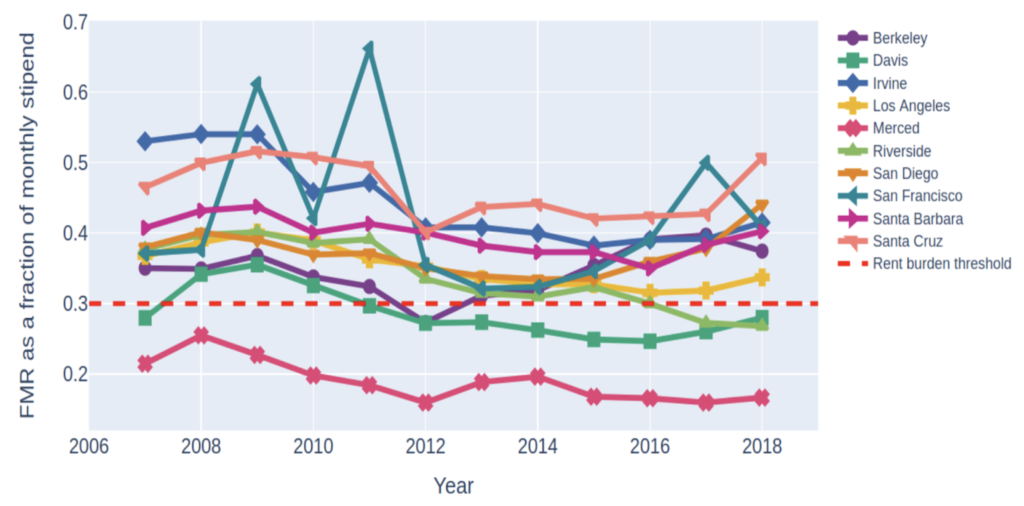“Beyond astro-ph” articles are not necessarily intended to be representative of the views of the entire Astrobites collaboration, nor do they represent the views of the AAS or all astronomers. While AAS is one of our co-sponsors, Astrobites is editorially independent and content that appears on Astrobites is not reviewed or approved by the AAS. Furthermore, this post was written by a subset of Astrobites authors (Sunayana Bhargava, Caitlin Doughty, Michael Foley, Gourav Khullar, and Tarini Konchady) and does not necessarily reflect the views of the whole collaboration. This post has been partially informed by quotes received from graduate students at universities with unions.
This post is the first of a two-part series about graduate student unions. In the next post, we’ll discuss the broader current context of graduate student unions, ongoing conflicts between unions and university administrations, and the response of both unions and administrations to the Covid-19 crisis.
The ongoing strike at the University of California, Santa Cruz (UCSC) between its graduate students and the administration has been making national news since December. There is a lot of jargon that surrounds the strike and unionization, though, so in this post we break down what a graduate student union in the United States is, why they are becoming more common, and what graduate students hope to gain by participating. Astrobites is run by graduate students, so exploring the ways unions are able to support us, as well as their broader role within academia, is a highly relevant topic.
At the heart of the UCSC dispute lies the refusal of the UCSC administration to provide all graduate students, regardless of residence, visa, documentation, employment or funding status, with a Cost of Living Adjustment (COLA), in the form of additional pay. The reason for this demand is to help make Santa Cruz more affordable and therefore lift the majority of students out of rent burden (Fig 1). The exact figure being demanded is an additional $1412 per month. You can see how this figure has been calculated here.

A full timeline of the strike is available here, but the most salient points are as follows:
- The strike began on December 9th 2019, when over 250 UCSC graduate students agreed to withhold grades for the fall quarter until demands for a COLA were met.
- A ‘full’ strike began in early February, during which hundreds of grads, undergrads, faculty and supporters withdrew from their duties at UCSC.
- Strikers also stood off with numerous strike-breaking police, with reports that 17 students were arrested, and others had sustained injuries in encounters with law enforcement.
- On February 28th, 82 TAs were fired from their teaching positions.
- On March 10th, the global pandemic resulted in all UCSC classes going online, and hence the UCSC picket line becoming “digital.”
- On March 29th, UCSC offered a “last chance agreement” to grad students offering to reinstate them if they turned in withheld Fall grades. Striking grad students instead responded with a counteroffer.
Numerous other UCs have been involved in bargaining the terms of their own COLA, both in solidarity with UCSC and to deal with rising costs across California. As of April 22nd, grad students at University of California, Santa Barbara (UCSB) are on a full teaching strike, while students at the University of California, Davis (UC Davis), the University of California, San Diego (UCSD), and University of California, Berkeley (UCB) are withholding grades. The University of California, Irvine (UCI) is also on a social welfare strike. An up-to-date list of the UCs involved in the COLA for all movements can be found here.
A brief history of graduate student unions in the United States
The UCSC COLA negotiations follow in the footsteps of many attempts at collective bargaining by graduate students and graduate student unions. In their current form, graduate student unions typically consist of student assistants who carry out teaching and research work. However, there are outliers like Rutgers, where the Rutgers AAUP-AFT advocates for faculty, postdocs, lecturers, and graduate students alike.
Efforts to form graduate student unions in the US began in the 1960s. The success of these efforts has been varied, with political whims playing a major role. The first recognized graduate student union was at the University of Wisconsin-Madison, which formed in 1969 in response to proposed legislation that would remove out-of-state tuition remission.
The 1990s saw a wave of unionization attempts at American universities, prompted by the need for better living conditions and the power to bargain collectively with the administration. This surge saw the United Auto Workers (UAW) getting involved in the movement on campuses, strengthening unionization efforts but also leading to internal conflict in recent years.
| Private Universities | Public Universities | |
| Governed by what laws? | National Labor Relations Act (NLRA) and National Labor Relations Board (NLRB) | State Labor Laws |
| Allowed to unionize? | Yes- in 2016, NLRB reversed the decision of the 2004 Brown University case. | Maybe – graduate students are technically state employees, so unionization is dependent on the state. |
| Examples where grad worker unions are recognized by university (Research or Teaching Assistants) | NYU, Harvard, Columbia | Universities in the UC system, UIUC, UW Madison, UMichigan, Rutgers, UWashington |
Here we provide a brief summary of the distinction between private and public university graduate unionization, in the context of the US academic and legal system (see the above table for a breakdown). The National Labor Relations Act (NLRA) covers private grad unionization. In 1951, the National Labor Relations Board (NLRB) — a federal agency governing these matters — decided in a case concerning Columbia University that all private grad students were not deemed to be engaging in work, and were just that — students. In 1970, this decision was reversed. Whether the NLRA ought to cover the rights of private grad workers has been a matter of contentious debate and legal back-and-forth for decades; as of 2016, the NLRB still considers private grad workers to be employees. It is crucial to note here that even though a graduate student body may decide to officially unionize, the university is under no obligation to recognize and bargain with a union.
Unions in state universities, which have several years of operations under their belt, have already done consequential work across the United States. The GEO (Graduate Employees’ Union) Grad Union at the University of Illinois- Urbana Champaign, in its latest iteration of contract negotiations in 2018, won a ~ 4% increase in pay across the board, increased commitment from the university to cover student fees and health insurance, and to officially consider microaggressions in the workplace as a valid grievance. GEO at the University of Michigan bargained for six graduate jobs for diversity, equity and inclusion labor and an increased $700 cap on mental health visits, alongside several protections for international grad students working on campus.
Effects of Unions on Graduate Student Life
In response to the COLA strike, UCSC recently announced a $2500 annual housing fellowship. According to a student involved in the UCSC strike, UCLA has also granted a housing stipend for graduates without summer funding. These concessions, while important, were made only in response to the strike, despite repeated efforts by graduate students and administration representatives to go through conventional channels over the past few years.
UCSC constitutes just one example of the impact of unions on graduate student life, highlighting that department, divisional and university-wide committees are not the only avenues for policy change. Over the course of the past few decades, unions have grown to be powerful vehicles for graduate students. Given that the concerns of graduate students are not monolithic, unionization facilitates dialogue and discussion. This, in turn, enables unions to condense the needs of a large, crucial population of the university into explicit demands, which can be presented to university administrations in an effective and immediate way. It is worth noting these demands are often not just about resolving issues in the short term, but to tackle the structural barriers to prevent such disputes from occuring in the future. As one grad student at UCSC puts it, “The purpose of this strike is to get graduate students enough money to be able to afford basic living expenses. However, the implications of our movement and its success or failure are much broader.”
Further Resources:
Examples of Graduate Student Unions
Detailed History of Graduate Student Unions
See GEO full contract details here and full transcripts of quotes that will be used in both parts of the unionization series here



